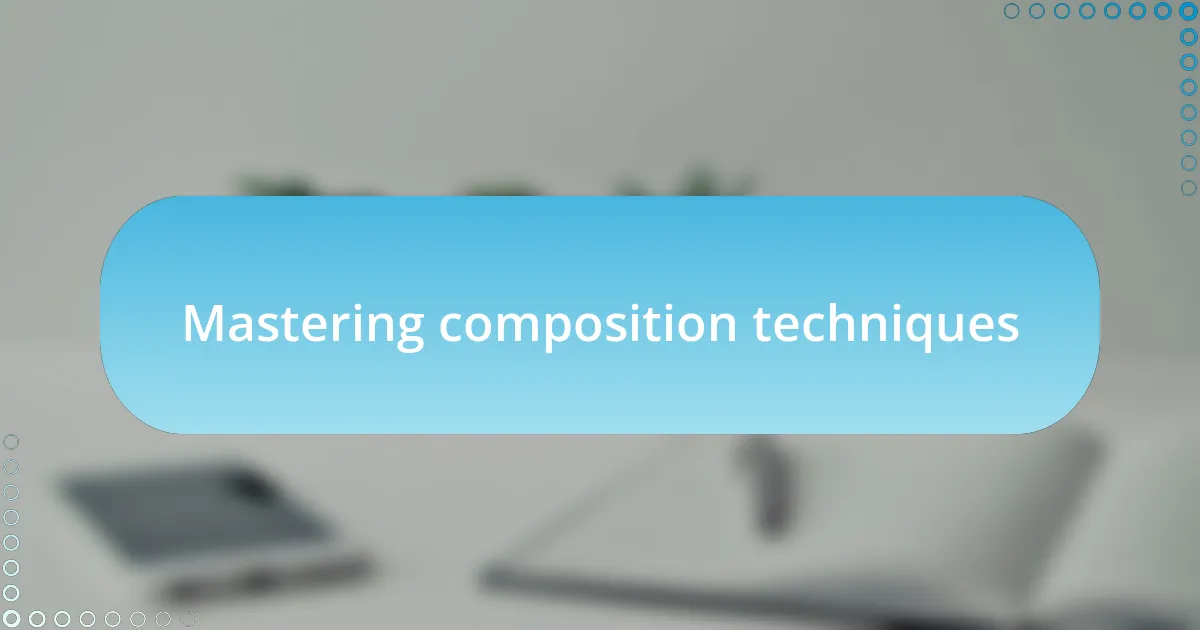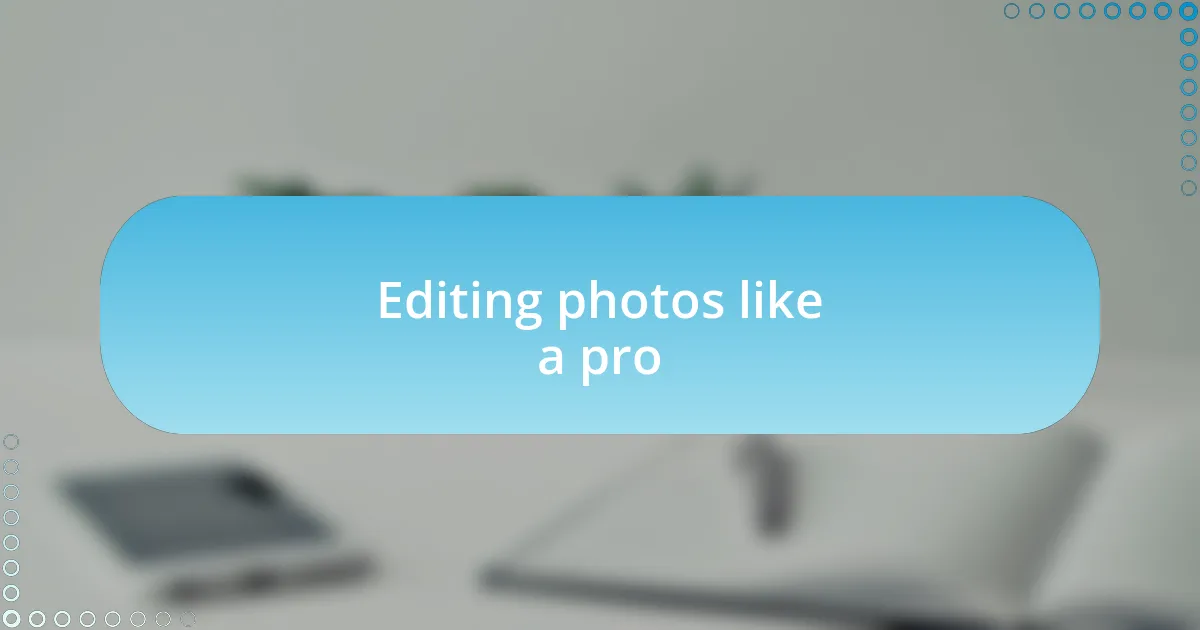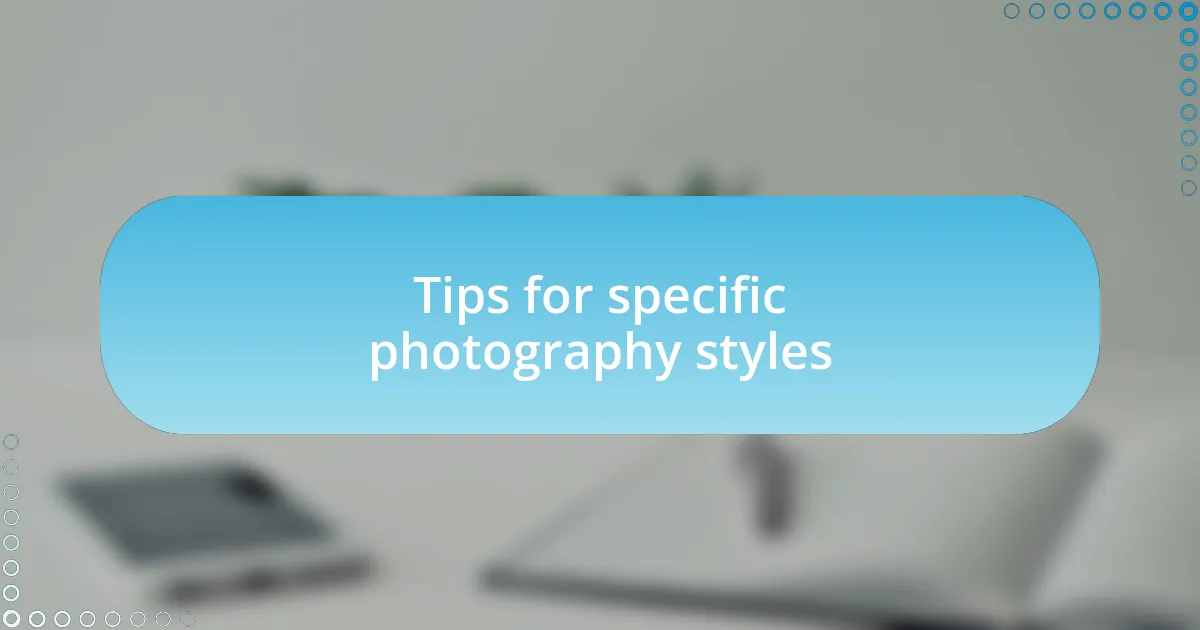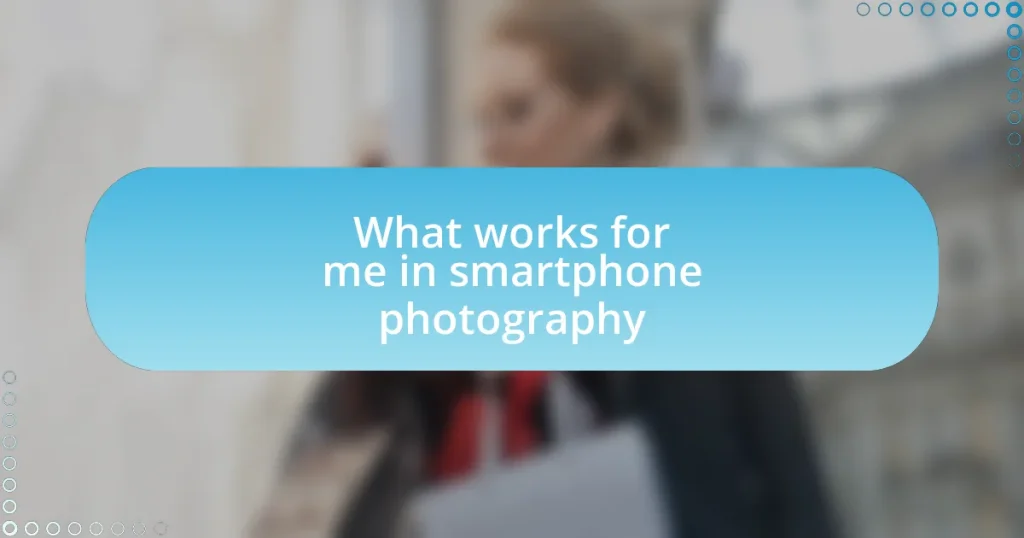Key takeaways:
- Smartphone photography benefits from understanding lighting, composition, and effective camera hardware to elevate image quality.
- Essential photography apps like Adobe Lightroom and Snapseed enhance editing capabilities, allowing for creativity and detail refinement.
- Mastering composition techniques, such as the Rule of Thirds and leading lines, improves visual storytelling in images.
- Utilizing natural light and shadows creatively can transform ordinary scenes into captivating photographs.

Understanding smartphone photography
Smartphone photography has revolutionized how we capture and share moments. I remember the first time I pulled out my phone to take a picture during a family gathering. It felt effortless compared to hauling around a bulky camera, and I loved the instant feedback. Doesn’t it amaze you how a simple tap can immortalize a fleeting memory?
One of the key aspects that often gets overlooked is lighting. I’ve learned the hard way that shooting under harsh sunlight can wash out colors, while golden hour provides that magical glow. Have you ever noticed how a photo changes completely based on the time of day? It’s those little nuances that can elevate a mundane snapshot into a work of art.
Finally, composing a shot can be surprisingly intuitive with smartphones, thanks to features like grid lines. I often align subjects using the rule of thirds, which I find can make a significant difference in the aesthetics. When was the last time you took a moment to consider the arrangement of your subject within the frame? Embracing these techniques turns everyday scenes into visually engaging stories.

Choosing the right smartphone
Choosing the right smartphone can significantly impact your photography experience. When I decided to upgrade my phone, I focused on the camera specifications, particularly the megapixels and aperture size. A higher megapixel count often delivers more detail, but I’ve discovered that a wider aperture can truly make your photos pop with depth. Have you ever considered how a camera’s hardware directly affects the images you capture?
Battery life is another critical factor that many overlook. During a weekend trip, I found myself in a stunning landscape, and my old phone’s battery couldn’t keep up, leaving me frustrated just when the lighting was perfect for a shot. It taught me the hard way that a good camera is useless if you can’t use it when inspiration strikes. Do you prioritize battery life in your smartphone choices?
Lastly, let’s not forget about software features. Some phones come with advanced photography settings and editing tools that can enhance your images significantly. When I discovered my smartphone’s night mode, it opened up a whole new world of possibilities for shooting after sunset. Have you explored the software capabilities on your device? It might surprise you how much they can elevate your photography.
| Smartphone Model | Camera Specs |
|---|---|
| iPhone 14 | 12MP Wide, 12MP Ultra Wide, f/1.5 |
| Samsung Galaxy S22 | 50MP Wide, 12MP Ultra Wide, f/1.8 |
| Google Pixel 6 | 50MP Wide, f/1.85 |
| OnePlus 10 Pro | 48MP Wide, 50MP Ultra Wide, f/1.8 |

Essential photography apps
When it comes to capturing stunning images, the right photography apps can truly elevate your smartphone photography game. I’ve experimented with various apps, and each one offers unique features that can help you express your creativity. For instance, I enjoy using editing apps that allow me to fine-tune my images. Sometimes, after a day of shooting, I sit down with my coffee and immerse myself in the editing process, transforming ordinary shots into something special.
Here are some of the essential photography apps that I’ve found invaluable:
- Adobe Lightroom: Perfect for advanced editing and organization of your photos.
- Snapseed: A user-friendly app that offers a wide range of editing tools and filters.
- VSCO: Known for its beautiful presets, it’s great for creating a consistent aesthetic.
- ProCamera: Offers manual controls to tweak exposure and focus, giving you more creative freedom.
- Halide: A powerful app that provides RAW photo capability and is perfect for serious enthusiasts.
In my experience, each app has something unique to offer, and I often switch between them depending on the mood or project. It’s like having a digital toolbox that makes photography feel even more engaging. What apps do you enjoy that help you capture those perfect moments?

Mastering composition techniques
Mastering composition techniques is a game changer in smartphone photography. One technique I often rely on is the Rule of Thirds. Imagine dividing your frame into a grid, creating nine equal squares—this approach helps me place my subjects at the intersections, drawing the viewer’s eye and adding balance. I remember a day at the beach when I positioned a lone surfer to the side of my shot, and it just transformed the whole image.
Another essential composition tool I cherish is leading lines. It’s fascinating how a winding path or a river can naturally guide the viewer’s gaze toward the focal point of the photo. I once took a hike with friends, capturing a stunning view framed by trees lining a narrow trail. That image, with the path leading into the distance, felt inviting and made the viewer want to step right into the scene.
Don’t underestimate the power of perspective, either. Shooting from different angles often reveals unexpected beauty. I’ve had moments where I’ve crouched low to the ground or stood on my tiptoes to capture a fresh viewpoint. Each time, it opened up new opportunities for creativity, and I found myself excited by the possibilities. Have you ever changed your angle and discovered a whole new world in what seemed like an ordinary moment?

Utilizing lighting effectively
The way I leverage natural light has significantly shaped my smartphone photography. Daylight can transform a simple scene into something magical. For instance, I once captured a flower garden just as the sun dipped below the horizon, casting a warm golden hue over everything. The gentle light added depth, making those blossoms pop. Have you ever noticed how much a slight shift in lighting can change the mood of a photograph?
I also love experimenting with shadows. They can add an intriguing layer of complexity to my images. I recall a time at a bustling market where I found myself fascinated by the way shadows danced across vibrant produce. By carefully framing the shot to emphasize those shadows, I created a dynamic image that told a story beyond just what was displayed. It’s moments like these that remind me how important it is to pay attention to not just light but what it leaves behind.
When shooting indoors or in dim light, I prioritize my settings or consider using additional light sources. I often carry a small, portable LED light that I can set up as needed. During a dinner gathering, I used this light to illuminate a beautifully plated dish, wiping away any underexposed areas. The resulting image was bright and appetizing, making me wonder how many delicious moments can be enhanced through proper lighting. Do you think about the light before snapping a photo? It really does make all the difference!

Editing photos like a pro
Editing has become an essential part of my smartphone photography journey. I still remember the first time I edited a photo of my dog playing in the field. With just a few taps, I boosted the colors and adjusted the contrast, transforming a mundane snapshot into a vibrant depiction of his joyful energy. It made me realize that editing is not just about correction; it’s about enhancing the emotional connection a viewer can have with the image. Have you ever felt a photo come to life with just a little editing magic?
When I’m tackling edits, I usually rely on a couple of user-friendly apps. For instance, Snapseed has been a favorite of mine for its wide range of tools, from selective adjustments to healing brushes. Just the other day, I was editing a sunset shot from my balcony, and I was able to smooth out distracting elements in the background while enhancing the sky’s rich hues. More than just fixing flaws, it’s these decisions during editing that help convey the story I want to tell. What features do you find most valuable in your editing apps?
Sometimes, the smallest adjustments can yield the most significant results. I’ve learned to be mindful of framing and cropping; an effective crop can draw attention to the main subject and eliminate unnecessary distractions. I recall a candid shot of my niece at a family gathering that felt cluttered until I cropped it down to focus on her joyful expression. That one tweak transformed the image from busy to breathtaking. How often do you review your images to see what might be enhanced or simplified?

Tips for specific photography styles
When it comes to landscape photography, I’ve learned that the time of day can make all the difference. I remember capturing a serene lake scene during the golden hour, just after sunrise. The warm light reflected off the water, creating an ethereal glow that made the whole image feel alive. Have you ever noticed how soft, natural light can breathe life into your landscapes? Always keep an eye on the skies, too; dramatic clouds can add depth and interest, turning an ordinary scene into something truly captivating.
For portrait photography, I tend to favor natural backdrops that complement my subject rather than distract from them. One memorable moment was when I took some candid shots of my friend in a blooming garden. The colorful flowers framed her perfectly, enhancing her smile and adding vibrancy to the image. Do you pay attention to your surroundings? I find that the right environment can elevate your portraits, conveying a story that resonates with viewers.
When experimenting with street photography, capturing fleeting moments is key. I once stumbled upon a street musician pouring his heart into a performance; I snapped a shot just as he closed his eyes, lost in the music. That image encapsulated raw emotion and spontaneity, a snapshot of real life to cherish forever. How often do you take risks with your photography? Allowing yourself to explore and embrace the unexpected can lead to some of your most profound works.
















